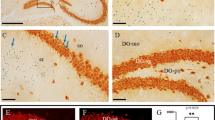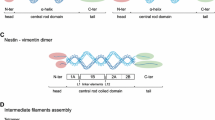Abstract
p75 neurotrophin receptor (p75NTR) is a member of the tumor necrosis factor superfamily, and plays a significant role in nervous system development. p75NTR has a dual (proliferative/apoptotic) role in neurogenesis and binds pro-neurotrophins with high affinity. Recent work suggests p75NTR is overexpressed in the developing cerebellum and in nodular/desmoplastic medulloblastomas. We analyzed p75NTR expression in various parts of the fetal and adult human central nervous system, and in 75 patients with medulloblastomas. The expression of p75NTR in the fetal brain was seen solely within the external granular layer with weaker expression in the Purkinje layer, which most likely represents Purkinje cell staining. The staining was present in gestational weeks 20–40, while no staining was identified elsewhere in the fetal brain or within the adult cerebellum. p75NTR positive cells were also positive with the proliferation marker ki-67, but were negative for ret, reelin, CD133, CD34, and cleaved caspase 3. Nine of 75 medulloblastomas (12%) were also showed positive immunostaining for p75NTR. The staining was seen in four classic, two desmoplastic, and three anaplastic medulloblastomas. The persistence of p75NTR in a small group of medulloblastomas raises the possibility that in such tumors, the receptor could be a potential therapeutic target.




Similar content being viewed by others
References
Hempstead BL (2002) The many faces of p75NTR. Curr Opin Neurobiol 12(3):260–267. doi:10.1016/S0959-4388(02)00321-5
Schor NF (2005) The p75 neurotrophin receptor in human development and disease. Prog Neurobiol 77(3):201–214. doi:10.1016/j.pneurobio.2005.10.006
Reichardt LF (2006) Neurotrophin-regulated signalling pathways. Philos Trans R Soc Lond 361(1473):1545–1564. doi:10.1098/rstb.2006.1894
Mischel PS, Smith SG, Vining ER, Valletta JS, Mobley WC, Reichardt LF (2001) The extracellular domain of p75NTR is necessary to inhibit neurotrophin-3 signaling through TrkA. J Biol Chem 276(14):11294–11301. doi:10.1074/jbc.M005132200
Nykjaer A, Willnow TE, Petersen CM (2005) p75NTR—live or let die. Curr Opin Neurobiol 15(1):49–57. doi:10.1016/j.conb.2005.01.004
Friedman WJ (2000) Neurotrophins induce death of hippocampal neurons via the p75 receptor. J Neurosci 20(17):6340–6346
Lu B, Pang PT, Woo NH (2005) The yin and yang of neurotrophin action. Natl Rev 6(8):603–614. doi:10.1038/nrn1726
Naumann T, Casademunt E, Hollerbach E, Hofmann J, Dechant G, Frotscher M, Barde YA (2002) Complete deletion of the neurotrophin receptor p75NTR leads to long-lasting increases in the number of basal forebrain cholinergic neurons. J Neurosci 22(7):2409–2418
Carter AR, Berry EM, Segal RA (2003) Regional expression of p75NTR contributes to neurotrophin regulation of cerebellar patterning. Mol Cell Neurosci 22(1):1–13. doi:10.1016/S1044-7431(02)00015-5
Chen EY, Mufson EJ, Kordower JH (1996) TRK and p75 neurotrophin receptor systems in the developing human brain. J Comp Neurol 369(4):591–618. doi:10.1002/(SICI)1096-9861(19960610)369:4<591::AID-CNE8>3.0.CO;2-#
Ellison D (2002) Classifying the medulloblastoma: insights from morphology and molecular genetics. Neuropathol Appl Neurobiol 28(4):257–282. doi:10.1046/j.1365-2990.2002.00419.x
Eberhart CG (2007) In search of the medulloblast: neural stem cells and embryonal brain tumors. Neurosurg Clin N Am 18(1):59–69, viii–ix. doi:10.1016/j.nec.2006.10.005
Katsetos CD, Burger PC (1994) Medulloblastoma. Semin Diagn Pathol 11(2):85–97
Burger PC, Grahmann FC, Bliestle A, Kleihues P (1987) Differentiation in the medulloblastoma. A histological and immunohistochemical study. Acta Neuropathol 73(2):115–123. doi:10.1007/BF00693776
Kadota Y, Arai H, Sato K (1995) Neural differentiation and maturation in metastatic medulloblastoma—case report. Neurol Med Chir (Tokyo) 35(1):32–35. doi:10.2176/nmc.35.32
Pomeroy SL, Sutton ME, Goumnerova LC, Segal RA (1997) Neurotrophins in cerebellar granule cell development and medulloblastoma. J Neurooncol 35(3):347–352. doi:10.1023/A:1005841206252
Eberhart CG, Kaufman WE, Tihan T, Burger PC (2001) Apoptosis, neuronal maturation, and neurotrophin expression within medulloblastoma nodules. J Neuropathol Exp Neurol 60(5):462–469
Ellison DW, Onilude OE, Lindsey JC, Lusher ME, Weston CL, Taylor RE, Pearson AD, Clifford SC, United Kingdom Children’s Cancer Study Group Brain Tumour Committee (2005) Beta-Catenin status predicts a favorable outcome in childhood medulloblastoma: the United Kingdom Children’s Cancer Study Group Brain Tumour Committee. J Clin Oncol 23(31):7951–7957. doi:10.1200/JCO.2005.01.5479
Buhren J, Christoph AH, Buslei R, Albrecht S, Wiestler OD, Pietsch T (2000) Expression of the neurotrophin receptor p75NTR in medulloblastomas is correlated with distinct histological and clinical features: evidence for a medulloblastoma subtype derived from the external granule cell layer. J Neuropathol Exp Neurol 59(3):229–240
Iacobuzio-Donahue CA, Ryu B, Hruban RH, Kern SE (2002) Exploring the host desmoplastic response to pancreatic carcinoma: gene expression of stromal and neoplastic cells at the site of primary invasion. Am J Pathol 160(1):91–99
Eberhart CG, Kratz J, Wang Y, Summers K, Stearns D, Cohen K, Dang CV, Burger PC (2004) Histopathological and molecular prognostic markers in medulloblastoma: c-myc, N-myc, TrkC, and anaplasia. J Neuropathol Exp Neurol 63(5):441–449
Min HS, Lee YJ, Park K, Cho BK, Park SH (2006) Medulloblastoma: histopathologic and molecular markers of anaplasia and biologic behavior. Acta Neuropathol 112(1):13–20. doi:10.1007/s00401-006-0073-9
Stearns D, Chaudhry A, Abel TW, Burger PC, Dang CV, Eberhart CG (2006) c-myc overexpression causes anaplasia in medulloblastoma. Cancer Res 66(2):673–681. doi:10.1158/0008-5472.CAN-05-1580
Dahlstrand J, Lardelli M, Lendahl U (1995) Nestin mRNA expression correlates with the central nervous system progenitor cell state in many, but not all, regions of developing central nervous system. Brain Res Dev Brain Res 84(1):109–129. doi:10.1016/0165-3806(94)00162-S
Katsetos CD, Krishna L, Frankfurter A, Karkavelas G, Wolfe DE, Valsamis MP, Schiffer D, Vlachos IN, Urich H (1995) A cytomorphological scheme of differentiating neuronal phenotypes in cerebellar medulloblastomas based on immunolocalization of class III beta-tubulin isotype (beta III) and proliferating cell nuclear antigen (PCNA)/cyclin. Clin Neuropathol 14(2):72–81
Author information
Authors and Affiliations
Corresponding author
Rights and permissions
About this article
Cite this article
Barnes, M., Eberhart, C.G., Collins, R. et al. Expression of p75NTR in fetal brain and medulloblastomas: evidence of a precursor cell marker and its persistence in neoplasia. J Neurooncol 92, 193–201 (2009). https://doi.org/10.1007/s11060-008-9755-6
Received:
Accepted:
Published:
Issue Date:
DOI: https://doi.org/10.1007/s11060-008-9755-6




